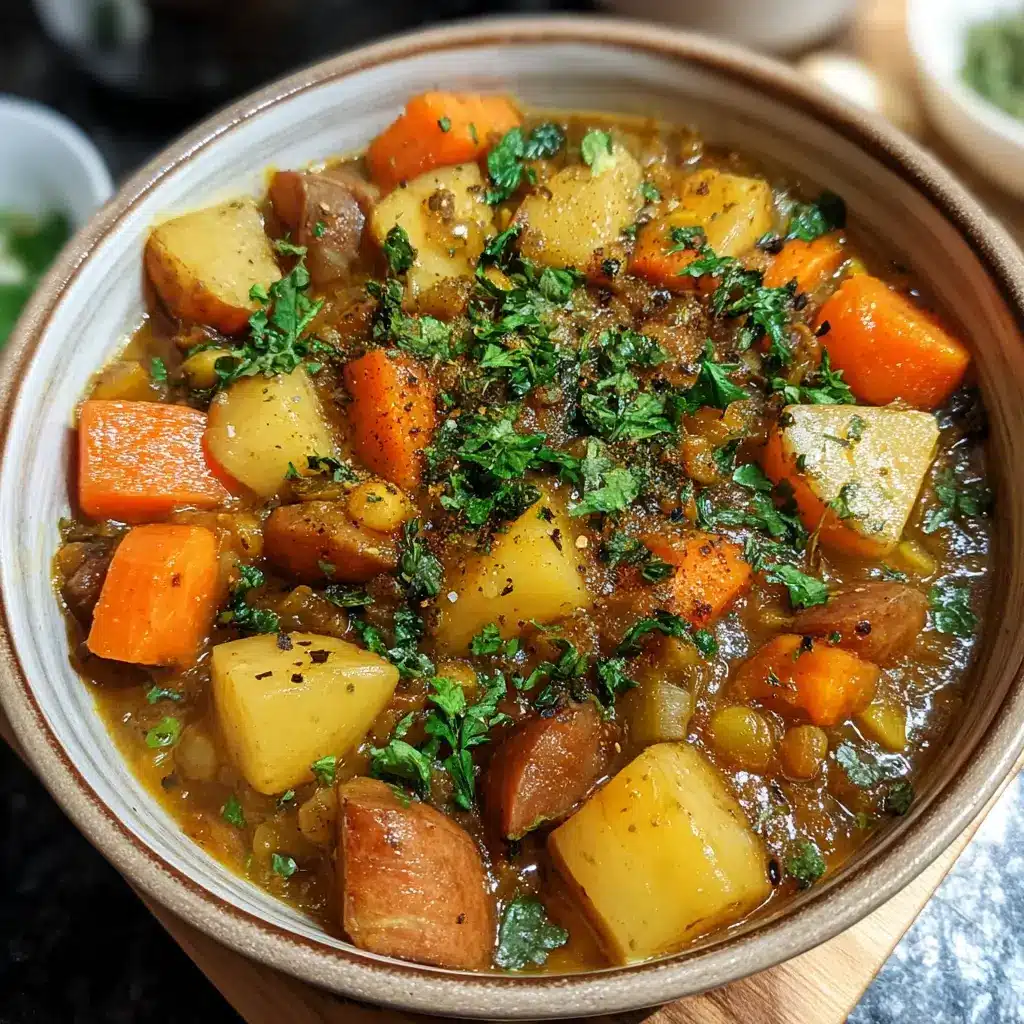There’s a particular aroma that instantly signals comfort in our home, a scent that wraps around you like the warmest, softest blanket on a chilly evening. It’s the deep, savory fragrance of this Hearty Vegan Stew simmering on the stove. I first developed this recipe on a whim, looking to create a meal that was not only nourishing and completely plant-based but also deeply satisfying—something that could stand up to the classic, meat-heavy stews I grew up with. The first time I served it, my family was skeptical. A stew without beef? But as they took their first spoonfuls, the silence was broken by murmurs of approval. My husband, a self-proclaimed carnivore, even asked for a second bowl. It has since become our go-to winter meal, a one-pot wonder that fills our bellies, warms our souls, and proves that plant-based cooking can be the most comforting food of all. This stew isn’t just a collection of vegetables; it’s a symphony of flavors and textures, with earthy mushrooms, tender lentils, and creamy potatoes all swimming in a rich, umami-packed broth that tastes like it has been slow-cooking for days, even though it comes together in just over an hour.
Complete Recipe: Ingredients You’ll Need
Before you begin your culinary journey to the most satisfying vegan stew, it’s essential to gather your ingredients. This concept, known as “mise en place” (everything in its place), will make the cooking process smooth, enjoyable, and stress-free. This recipe relies on a foundation of humble, accessible ingredients that, when combined and cooked with care, transform into something truly extraordinary. Each component plays a crucial role in building the layers of flavor that make this dish so memorable.
For the Stew Base (Aromatics and Vegetables):
- Olive Oil: 2 tablespoons, for sautéing. Use a good quality extra-virgin olive oil for a richer flavor.
- Yellow Onion: 1 large, finely chopped. Yellow onions provide a sweet, aromatic base when sautéed.
- Carrots: 2 large (about 1.5 cups), peeled and cut into ½-inch rounds or half-moons. They add a natural sweetness and vibrant color.
- Celery: 2 stalks (about 1 cup), cut into ½-inch pieces. Celery contributes a subtle, savory, and slightly peppery note that is essential for a classic stew base.
- Garlic: 4-5 cloves, minced. Don’t be shy with the garlic; it adds a pungent depth that is fundamental to the stew’s character.
- Cremini Mushrooms: 8 ounces (225g), cleaned and quartered or thickly sliced. Also known as “baby bellas,” these provide a meaty texture and deep, umami flavor.
- Yukon Gold Potatoes: 1.5 pounds (about 680g), scrubbed and cut into 1-inch cubes. Their waxy, creamy texture holds up well during cooking without turning to mush.
For Flavor, Liquid, and Protein:
- Tomato Paste: 2 tablespoons. This concentrated tomato flavor is a powerhouse for adding richness and a savory backbone.
- Dry Red Wine (Optional): ¼ cup. A splash of Cabernet Sauvignon, Merlot, or Pinot Noir is excellent for deglazing the pot and adding a complex, robust flavor. If you prefer to cook without alcohol, simply use extra vegetable broth.
- Vegetable Broth: 6 cups, low-sodium. Using a high-quality broth is key, as it forms the body of your stew.
- Canned Diced Tomatoes: 1 (14.5-ounce) can, with their juice. These add acidity and texture.
- Brown or Green Lentils: 1 cup, rinsed and picked over. These lentils retain their shape when cooked, adding a wonderful, hearty texture and a significant protein boost.
- Canned Chickpeas: 1 (15-ounce) can, rinsed and drained. They add another layer of texture and plant-based protein.
Herbs and Spices:
- Dried Thyme: 1 teaspoon.
- Dried Rosemary: 1 teaspoon, lightly crushed between your fingers to release its oils.
- Smoked Paprika: 1 teaspoon. This provides a subtle, smoky depth that mimics the heartiness of traditional stews.
- Bay Leaf: 1 whole leaf.
- Soy Sauce or Tamari: 2 tablespoons. This is a secret weapon for umami! Use tamari for a gluten-free option.
- Salt and Freshly Ground Black Pepper: To taste.
For Finishing:
- Balsamic Vinegar: 1 tablespoon. A splash at the end brightens all the flavors and adds a touch of balancing acidity.
- Fresh Parsley: ¼ cup, chopped, for garnish. It adds a final burst of freshness and color.
Step-by-Step Instructions for the Perfect Vegan Stew
Follow these detailed steps to build layers of flavor, ensuring your stew is rich, complex, and incredibly delicious. The key is to not rush the initial stages; this is where the magic truly begins.
Step 1: Sauté the Aromatics
In a large Dutch oven or heavy-bottomed pot, heat the olive oil over medium heat. Once the oil is shimmering, add the chopped yellow onion, carrots, and celery (this trio is known as a mirepoix). Sauté for 8-10 minutes, stirring occasionally, until the onions are translucent and softened and beginning to caramelize slightly. This slow sauté builds the foundational sweet and savory layer of your stew. Season generously with a pinch of salt and black pepper.
Step 2: Brown the Mushrooms and Bloom the Aromatics
Increase the heat to medium-high. Add the quartered cremini mushrooms to the pot. Allow them to cook without stirring for 2-3 minutes, so they can get a nice brown sear on one side. Then, continue to cook, stirring occasionally, for another 5-7 minutes, until they have released their liquid and are beautifully browned. This step is crucial for developing a deep, “meaty” flavor. Next, add the minced garlic and cook for just one minute more, until fragrant. Be careful not to burn the garlic.
Step 3: Create the Flavor Paste
Add the tomato paste, dried thyme, dried rosemary, and smoked paprika to the pot. Stir constantly for 1-2 minutes, allowing the tomato paste to darken slightly and the spices to “bloom.” This process toasts the spices and deepens the tomato flavor, removing any raw taste and creating a complex, aromatic base.
Step 4: Deglaze the Pot
If using, pour in the red wine to deglaze the pot. Use a wooden spoon or spatula to scrape up all the browned bits (the “fond”) from the bottom of the pot. These bits are packed with concentrated flavor. Let the wine simmer and reduce by about half, which should take about 2-3 minutes. If you are not using wine, use ¼ cup of the vegetable broth for this step.
Step 5: Simmer the Stew
Pour in the remaining vegetable broth, the can of diced tomatoes (with their juices), the rinsed lentils, the cubed potatoes, the soy sauce (or tamari), and the bay leaf. Stir everything together well to combine. Bring the stew to a boil, then reduce the heat to low, cover the pot, and let it simmer gently.
Step 6: The Long Simmer
Let the stew simmer for 40-50 minutes, stirring every 10-15 minutes to prevent anything from sticking to the bottom. The stew is ready for the next step when the lentils are tender and the potatoes can be easily pierced with a fork. The liquid should have thickened considerably into a rich, gravy-like consistency.
Step 7: Add the Final Components
Once the potatoes and lentils are tender, stir in the rinsed and drained chickpeas. Allow them to heat through for about 5 minutes. If the stew seems too thick at this point, you can add a splash more vegetable broth to reach your desired consistency.
Step 8: Finish and Serve
Turn off the heat. Remove the bay leaf. Stir in the balsamic vinegar and the fresh chopped parsley. The vinegar will brighten and balance all the deep, savory flavors. Taste the stew one final time and adjust the seasoning with more salt and pepper if needed. Let the stew rest for 5-10 minutes before serving to allow the flavors to meld perfectly.
Nutrition Facts
Please note that these values are an estimate and can vary based on the specific ingredients and brands used. This stew is designed to be a well-rounded, nutrient-dense meal.
- Servings: This recipe makes approximately 8 generous servings.
- Calories per serving: Approximately 380 kcal.
This Hearty Vegan Stew is not only comforting but also a nutritional powerhouse. It is rich in dietary fiber from the lentils, vegetables, and chickpeas, which is excellent for digestive health. It also provides a substantial amount of plant-based protein, essential vitamins like Vitamin A and C from the carrots and tomatoes, and important minerals like iron and potassium.
Preparation Time
Investing a little time in this stew pays off with a meal that can feed you for days and tastes even better as leftovers.
- Prep Time: 20 minutes (for chopping vegetables and gathering ingredients).
- Cook Time: 1 hour to 1 hour 10 minutes.
- Total Time: Approximately 1 hour 30 minutes.
How to Serve Your Hearty Vegan Stew
Serving this stew is half the fun. Its robust character makes it a versatile centerpiece for a variety of meal presentations. Here are some of our favorite ways to enjoy it:
- The Classic Way:
- Ladle the hot stew into deep, rustic bowls.
- Serve with a side of warm, crusty bread (like a sourdough or a French baguette) for dipping into the rich, savory broth. This is non-negotiable in our house!
- Served Over a Base:
- Creamy Polenta: Spoon the stew over a bed of soft, creamy vegan polenta for an incredibly comforting and elegant meal.
- Fluffy Quinoa: For an extra protein and fiber boost, serve the stew over cooked quinoa.
- Brown Rice: A simple bed of brown rice provides a nutty complement to the stew’s flavors.
- Mashed Potatoes: For the ultimate comfort food experience, serve it over a pile of fluffy vegan mashed potatoes.
- With a Variety of Toppings:
- Fresh Herbs: A sprinkle of additional fresh parsley, dill, or chives adds a burst of freshness.
- Creamy Dollop: A spoonful of vegan sour cream or a drizzle of homemade cashew cream can add a cool, tangy contrast.
- Crunchy Element: Top with crispy roasted chickpeas, toasted pumpkin seeds, or rustic croutons for a delightful textural contrast.
- Cheesy Flavor: A generous sprinkle of nutritional yeast over the top adds a savory, cheesy, umami kick.
- A Drizzle of Oil: A final, light drizzle of high-quality extra-virgin olive oil can enhance the richness.
Additional Tips for Stew Success
Over the years, I’ve learned a few tricks that elevate this stew from great to absolutely unforgettable. Here are five tips to ensure your stew is perfect every time.
- Don’t Rush the Sauté (The Foundation of Flavor): The initial 10 minutes of sautéing the onion, carrots, and celery is arguably the most important step. Rushing this will result in a stew that lacks depth. You are not just softening the vegetables; you are building the first layer of flavor by allowing their natural sugars to release and caramelize. Similarly, taking the time to properly brown the mushrooms is essential for creating a deep, savory, umami flavor that gives the stew its “meaty” quality.
- Embrace “Mise en Place”: This French term for “everything in its place” will transform your cooking experience. Before you turn on the stove, take the 20 minutes to chop all your vegetables, measure out your spices, and open your cans. With everything prepped and ready, the cooking process becomes a smooth, flowing, and enjoyable activity rather than a frantic search for the next ingredient. It also prevents you from burning the onions while you’re still chopping the carrots.
- Taste and Adjust Seasoning at the End: It’s tempting to salt the stew heavily at the beginning, but resist the urge. As the stew simmers and the liquid reduces, the flavors—including the saltiness—will concentrate. Wait until the very end, just before serving, to do your final taste test. You may find it needs less salt than you initially thought. This is also the best time to check if it needs a bit more pepper, a touch more soy sauce for umami, or that final, crucial splash of balsamic vinegar to brighten everything up.
- Make It Ahead for Even Better Flavor: Like many stews, soups, and chilis, this Hearty Vegan Stew benefits from a day of rest. The flavors continue to meld and deepen as it sits in the refrigerator overnight. This makes it an absolutely perfect dish for meal prep. Make a big batch on Sunday, and you’ll have delicious, easy, and flavorful lunches or dinners ready for the busy week ahead. The texture becomes even richer and more cohesive.
- Mastering the Thickness: The final consistency of your stew is a matter of personal preference. If your stew is thinner than you’d like, you can create a “slurry” by mixing 1 tablespoon of cornstarch with 2 tablespoons of cold water until smooth, then stirring it into the simmering stew for a few minutes until it thickens. Alternatively, you can scoop out about a cup of the stew (with potatoes), mash it with a fork, and stir it back in to naturally thicken the base. If your stew becomes too thick, simply stir in a bit more vegetable broth until you reach your desired consistency.
Frequently Asked Questions (FAQ)
1. Can I make this vegan stew in a slow cooker or Instant Pot?
Absolutely! This recipe is very adaptable.
- For a Slow Cooker: Complete steps 1-4 on the stovetop to build that crucial flavor base. Then, transfer everything to the slow cooker. Add the remaining ingredients (except the chickpeas, vinegar, and parsley), and cook on low for 6-8 hours or on high for 3-4 hours. Stir in the chickpeas, vinegar, and parsley during the last 15-20 minutes of cooking.
- For an Instant Pot: Use the “Sauté” function to complete steps 1-4 directly in the Instant Pot liner. After deglazing, add the remaining ingredients (except chickpeas, vinegar, and parsley). Secure the lid, set the valve to “Sealing,” and cook on High Pressure for 12 minutes. Let the pressure release naturally for 10 minutes, then perform a quick release. Stir in the chickpeas, vinegar, and parsley, and serve.
2. How do I store and reheat leftovers?
Leftovers are fantastic! Allow the stew to cool completely before transferring it to an airtight container. It will keep in the refrigerator for up to 5 days. To reheat, gently warm it in a saucepan over medium-low heat, adding a splash of water or vegetable broth if it has thickened too much. You can also reheat individual portions in the microwave. This stew also freezes beautifully for up to 3 months.
3. Can I make this recipe gluten-free?
Yes, it’s very easy to make this stew gluten-free. The only ingredient you need to be mindful of is the soy sauce. Simply substitute the soy sauce with an equal amount of tamari or a gluten-free liquid aminos. Also, double-check that your vegetable broth is certified gluten-free, as some brands can contain hidden gluten.
4. What other vegetables can I add to this stew?
This recipe is a great canvas for whatever vegetables you have on hand. Feel free to get creative! Some wonderful additions include:
- Root Vegetables: Cubed sweet potatoes or parsnips can be added along with the Yukon Gold potatoes.
- Greens: Stir in a few large handfuls of chopped kale or spinach during the last 5-10 minutes of cooking until they are wilted and tender.
- Other Veggies: Chopped bell peppers (any color) can be added with the onions, and a cup of frozen peas or corn can be stirred in with the chickpeas at the end.
5. My stew tastes a little bland. How can I fix it?
If your stew isn’t “popping” with flavor, there are several things you can do to fix it. First, and most commonly, it might just need more salt. Add a small amount, stir, and taste again. If it’s still missing something, try one of these flavor boosters: a splash more soy sauce/tamari for umami, an extra teaspoon of balsamic vinegar to brighten the flavors, a big handful of fresh parsley, or even a pinch of sugar to balance the acidity of the tomatoes. A dash more smoked paprika can also amplify the savory, smoky notes.

Hearty Vegan Stew Recipe
Ingredients
For the Stew Base (Aromatics and Vegetables):
- Olive Oil: 2 tablespoons, for sautéing. Use a good quality extra-virgin olive oil for a richer flavor.
- Yellow Onion: 1 large, finely chopped. Yellow onions provide a sweet, aromatic base when sautéed.
- Carrots: 2 large (about 1.5 cups), peeled and cut into ½-inch rounds or half-moons. They add a natural sweetness and vibrant color.
- Celery: 2 stalks (about 1 cup), cut into ½-inch pieces. Celery contributes a subtle, savory, and slightly peppery note that is essential for a classic stew base.
- Garlic: 4-5 cloves, minced. Don’t be shy with the garlic; it adds a pungent depth that is fundamental to the stew’s character.
- Cremini Mushrooms: 8 ounces (225g), cleaned and quartered or thickly sliced. Also known as “baby bellas,” these provide a meaty texture and deep, umami flavor.
- Yukon Gold Potatoes: 1.5 pounds (about 680g), scrubbed and cut into 1-inch cubes. Their waxy, creamy texture holds up well during cooking without turning to mush.
For Flavor, Liquid, and Protein:
- Tomato Paste: 2 tablespoons. This concentrated tomato flavor is a powerhouse for adding richness and a savory backbone.
- Dry Red Wine (Optional): ¼ cup. A splash of Cabernet Sauvignon, Merlot, or Pinot Noir is excellent for deglazing the pot and adding a complex, robust flavor. If you prefer to cook without alcohol, simply use extra vegetable broth.
- Vegetable Broth: 6 cups, low-sodium. Using a high-quality broth is key, as it forms the body of your stew.
- Canned Diced Tomatoes: 1 (14.5-ounce) can, with their juice. These add acidity and texture.
- Brown or Green Lentils: 1 cup, rinsed and picked over. These lentils retain their shape when cooked, adding a wonderful, hearty texture and a significant protein boost.
- Canned Chickpeas: 1 (15-ounce) can, rinsed and drained. They add another layer of texture and plant-based protein.
Herbs and Spices:
- Dried Thyme: 1 teaspoon.
- Dried Rosemary: 1 teaspoon, lightly crushed between your fingers to release its oils.
- Smoked Paprika: 1 teaspoon. This provides a subtle, smoky depth that mimics the heartiness of traditional stews.
- Bay Leaf: 1 whole leaf.
- Soy Sauce or Tamari: 2 tablespoons. This is a secret weapon for umami! Use tamari for a gluten-free option.
- Salt and Freshly Ground Black Pepper: To taste.
For Finishing:
- Balsamic Vinegar: 1 tablespoon. A splash at the end brightens all the flavors and adds a touch of balancing acidity.
- Fresh Parsley: ¼ cup, chopped, for garnish. It adds a final burst of freshness and color.
Instructions
Step 1: Sauté the Aromatics
In a large Dutch oven or heavy-bottomed pot, heat the olive oil over medium heat. Once the oil is shimmering, add the chopped yellow onion, carrots, and celery (this trio is known as a mirepoix). Sauté for 8-10 minutes, stirring occasionally, until the onions are translucent and softened and beginning to caramelize slightly. This slow sauté builds the foundational sweet and savory layer of your stew. Season generously with a pinch of salt and black pepper.
Step 2: Brown the Mushrooms and Bloom the Aromatics
Increase the heat to medium-high. Add the quartered cremini mushrooms to the pot. Allow them to cook without stirring for 2-3 minutes, so they can get a nice brown sear on one side. Then, continue to cook, stirring occasionally, for another 5-7 minutes, until they have released their liquid and are beautifully browned. This step is crucial for developing a deep, “meaty” flavor. Next, add the minced garlic and cook for just one minute more, until fragrant. Be careful not to burn the garlic.
Step 3: Create the Flavor Paste
Add the tomato paste, dried thyme, dried rosemary, and smoked paprika to the pot. Stir constantly for 1-2 minutes, allowing the tomato paste to darken slightly and the spices to “bloom.” This process toasts the spices and deepens the tomato flavor, removing any raw taste and creating a complex, aromatic base.
Step 4: Deglaze the Pot
If using, pour in the red wine to deglaze the pot. Use a wooden spoon or spatula to scrape up all the browned bits (the “fond”) from the bottom of the pot. These bits are packed with concentrated flavor. Let the wine simmer and reduce by about half, which should take about 2-3 minutes. If you are not using wine, use ¼ cup of the vegetable broth for this step.
Step 5: Simmer the Stew
Pour in the remaining vegetable broth, the can of diced tomatoes (with their juices), the rinsed lentils, the cubed potatoes, the soy sauce (or tamari), and the bay leaf. Stir everything together well to combine. Bring the stew to a boil, then reduce the heat to low, cover the pot, and let it simmer gently.
Step 6: The Long Simmer
Let the stew simmer for 40-50 minutes, stirring every 10-15 minutes to prevent anything from sticking to the bottom. The stew is ready for the next step when the lentils are tender and the potatoes can be easily pierced with a fork. The liquid should have thickened considerably into a rich, gravy-like consistency.
Step 7: Add the Final Components
Once the potatoes and lentils are tender, stir in the rinsed and drained chickpeas. Allow them to heat through for about 5 minutes. If the stew seems too thick at this point, you can add a splash more vegetable broth to reach your desired consistency.
Step 8: Finish and Serve
Turn off the heat. Remove the bay leaf. Stir in the balsamic vinegar and the fresh chopped parsley. The vinegar will brighten and balance all the deep, savory flavors. Taste the stew one final time and adjust the seasoning with more salt and pepper if needed. Let the stew rest for 5-10 minutes before serving to allow the flavors to meld perfectly.
Nutrition
- Serving Size: One Normal Portion
- Calories: 380 kcal





